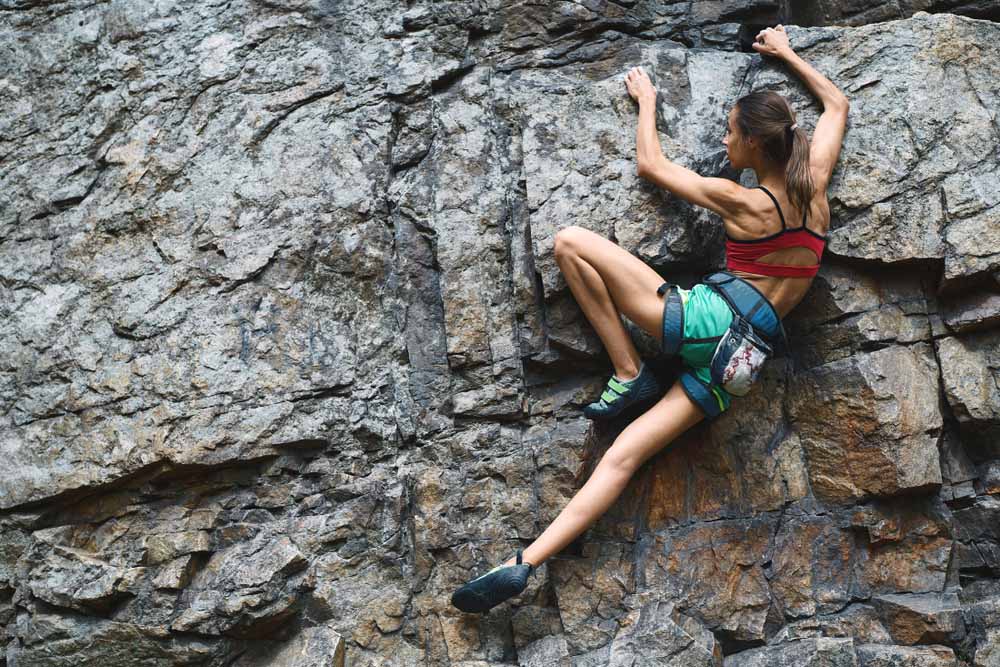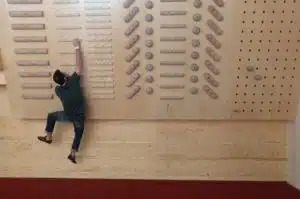How do you currently train?
Chances are, that like most climbers you don’t.
You head to the gym and “just climb”. And “just climbing” is awesome. You have a great time, socialize with your friends and if you’re one of the lucky few, “just climbing” can take you pretty far.
But most people, even those pushing themselves will eventually hit the proverbial plateau of progression. Your onsight or redpoint doesn’t improve much as the years trickle by and that one finger pull-up seems lightyears away.
How do we get through this? Enter Periodization.
In this post we first look at periodization in general and once we’ve reviewed the basic stuff we look at what we’re all really interested in: Periodization in climbing.
What is Periodization?

Periodization is a general way of separating your training into different blocks or phases.
Each block will individually have a specific purpose or a certain goal. They are organised or performed in such a manner as to provide progressively increasing performance in a controlled manner, provide a peak performance window.
There are two major advantages to periodization:
- General progression and increased performance through each cycle.
- A reduction in the possibility of getting injured or overtraining.
These two points by themselves should be enough to persuade anyone who’s been climbing long enough to give it a try.
You could think of periodization as changing the variables in the training equation in order to maximise performance whilst minimizing the risk.
The 3 Different Phases

The names of these different phases are often ignored when we get into the nitty-gritty of a training plan, but let’s include them just incase you see one thrown in someday when discussing things with your future coach:
- Macrocycle. This is the long term training period and big picture. For Olympians this can be four years. If you’re heading to Yosemite next year to attempt the dream big-wall, it could be 1 year.
- Mesocycle. Within the macrocycle we have smaller mesocycles. These depend on the overall goal but will introduce increased intensity over the period, such as every 2/3 weeks – 4months.
- Microcycle. The shortest duration within a mesocycle. Again they vary but are generally counted in weeks.
The Goals of Each Phases

Each phase will have a specific purpose and different goal. These are generally:
- Endurance phase. Effort is in the 50-75% range with moderate to high volume.
- Strength phase. Effort is in the 80-90% range with a mid-volume.
- Power phase. This is strength with movement. High intensity in the 75%-95% range, with low volume.
- Performance/Peak phase. This is Max effort/close to failure with very low volume.
Overall, structuring the different phases in a certain manner has the aim of allowing you to achieve your performance goals.
The Different Types of Periodization
The type of periodization determines the way you increase the load or intensity of the training. It could be increasing the grade of the climbs or boulders or changing the volume of laps you do.
There are 3 types:
- Linear. The load and volume over intermediate mesocycles cycles is linearly increased.
- Non-linear or undulating. Load and volume are changed much more frequently, such as daily, per training session, or weekly.
- Reverse. This is more specific to endurance sports and can be appropriate for climbing depending on your goal. Here the load is decreased while the volume is increased.
Periodization in Climbing

Implementing periodization in climbing means tailoring the various blocks and phases specifically to climbing.
One of the difficulties is that climbing requires capacity in multiple of the different phases, regardless of which discipline you practice most.
- Bouldering: This requires high levels of strength and power. But a day or week away bouldering will require endurance and the longer problems power endurance.
- Sport/Trad: Very clearly requires requires power-endurance, endurance and strength and power to get through crux sequences.
Therefore a training program will include all four phases, though with different amounts of time spent on each goal.
The goals of the different phases could be:
- Endurance phase. Performing laps on boulders, waterfalls, or simple laps of top-ropes or lead climbs.
- Strength phase. Fingerboarding.
- Power phase. Max or limit bouldering. Campus boarding for those advanced enough. Working the 2-4 crux moves of a project.
- Power-endurance phase. Onsight climbing.
The end of a power-endurance phase would coincide with around a week before you want to be in peak performance, allowing a small tapering-off period.
Structuring The Training Blocks

The way that you structure the training blocs should depend on your goals.
If you’re looking to remain in peak performance across the board for a prolonged period, an undulating program works well. You work power-endurance on one day, strength & power on the next, followed by endurance.
The disadvantage here is that with shorts period spent on each goal it can be difficult to really improve a certain area. Equally, given that you are working different parts very hard it can be easier to over-train.
During those dark winter months however you would probably want to spend longer on each of these blocks, with a linear program. This has the advantage of allowing real gains to be made in each area.
Periodization For Climbers: 2 Examples
Concretely, here are two typical examples of training programs used at both ends of the spectrum.
Linear Program – 4/5months:
- Phase 1: Long Endurance (6 weeks)
- Phase 2: Strength (4 weeks)
- Phase 3: Power (3 weeks)
- Phase 4: Power Endurance (2-4 weeks)
- Phase 5: Rest/Recovery (2 weeks)
+++ This type of program is great for making large gains in different areas and is therefore great for beginners or people new to structured training. It can also be beneficial for experienced climbers who want to focus on certain areas.
— The main drawback is that whilst you concentrate on an individual goal, the other areas will suffer. For example when you spend 4-6 weeks on strength, your endurance will decrease.
Undulating Program – 1 week:
- Phase 1 – Monday – Endurance
- Phase 2 – Wednesday – Strength & Power
- Phase 3 – Thursday – Power endurance
- Phase 4 – Saturday – Stamina
The weekly cycle is then repeated.
+++ This type of program is great in that you’re working multiple different aspects at an intense level. For high level and experienced climbers this can be great. A key point here is that more experienced climbers will be able to handle the regular intense amount of training and have a better feel for what their body can handle.
— The potential drawback is that as each session is of high difficulty it is easier to become fatigued or overtrain. This is therefore less suited to beginners. Equally as shorter periods are spent on each goal it can be more difficult to make large gains.
Benefits of Periodization
We’ve touched upon a few already, but the key benefits which cannot be emphasized more:
- Increased performance.
- Breaking through plateaus.
- Reduce the risk of overtraining and injury.
- Timing of performance peaks with trips or competitions.
Injury Prevention and Periodization
A small note.
It may seem counterintuitive but training in an intense but structured manner actually decreases your risk of injury.
In amateurs injuries often happen when we’re just winging it. “Go on, I’ll give it a go” at a hard boulder when you’re already fatigued from a long session.
When we train in a structured manner the unknown aspect is removed and you gain control of what you’re doing. The objective is to stick to the sets/reps/cycles including rest periods.
The risk of injury becomes more limited as you train in a controlled manner.
Downsides of Periodization
We all have to admit, training endurance can be a bit of a bore. Performing those multiple waterfalls or laps on the system/spray-wall can be a bit tedious.
You’ll also be in top performance for certain peak phases. If you time these wrong, such as an unexpected weekend trip, you may be in the completely wrong phase and not perform as expected ☹️
Conclusion
The goal is to train smarter and not just harder.
By using periodization, you remove the unknown factor in training and stop winging it. You limit the chance of getting injured and overtraining, all whilst getting stronger and improving on different areas of your climbing.
The key is to get started and not overthink it, aiming to have the perfect training plan.
Start with simple 2 week blocks of endurance, strength, power, power-endurnace and see how it goes. Once you feel the improvements you’ll get more interested in structured training and motivated to try new techniques.
But we must admit, “just climbing” is still the most fun.












